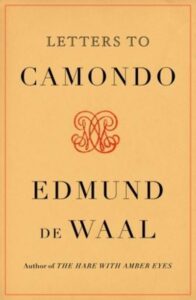Rob Moyer loves detective fiction, it’s true. But from time to time, his interest in human nature – including its darker sides – takes him into the serious nonfiction realm, and particularly into the horrors of the Holocaust.
Reviewed by Robert P. Moyer
LETTERS TO CAMONDO. By Edmund de Waal. Farrah, Straus and Giroux. 182 pages. $28.
 Edmund de Waal is a potter by trade. “Pottery,” however, is a crude word for the delicate pieces of porcelain he produces, and exhibits around the world — below ground, above ground, carefully arranged, often in the context of other works of art. His work is exquisite.
Edmund de Waal is a potter by trade. “Pottery,” however, is a crude word for the delicate pieces of porcelain he produces, and exhibits around the world — below ground, above ground, carefully arranged, often in the context of other works of art. His work is exquisite.
So are his books. His first, The Hare With Amber Eyes, is a sine qua non of memoirs cum musings. In it he traces the decimation and devastation of his family, the Ephrussis, and their fortune by the Nazis. Titans of the financial world, the extended family owned mansions in Vienna, Paris and Minsk, filled with invaluable works of art and books. All that was left after the war was a collection of Japanese netsuke, small carved objects attached to a kimono sash. By tracing their history, de Waal brings back the lives that touched them, saw them, owned them.
In Letters to Camondo, de Waal approaches the destiny of a family intertwined with his in the French belle epoque, the Camondos. They lived at 63 rue de Monceau, just down the boulevard in Paris from his family at 81. In 1936, Moise Camondo willed that house to the French nation to commemorate his son, a fighter pilot who died in WWI—the Musee Nissim Camondo. He filled it with the greatest private collection of 18th century art, dictating that nothing should ever be moved, nothing loaned, even detailing how objects should be dusted. Remarkably, thanks to a (secret) Jew in the World War II Vichy government, the house was spared the brutal expropriation of the Nazis. In a series of 58 letters to Moise, all in present tense, de Waal illustrates French Jewish history, collecting, and the nature of memory.
He seems to have unlimited access to the house and its archives. In his writing, he inhabits the objects, inhabits the house, and, ultimately, the mind of Camondo. He unearths lists of luncheons sponsored by the patriarch, organizations and societies he contributed and belonged to, the artists he supported, purchases of objects for the collection, all documenting how much he gave to France, not to mention the life of his son. He roams the house, sits in the room where Moise sat, learns “Objects are not seen by themselves but discovered among others.” He notices that “You put this here and set off small chords… . You put it there and it is just stuff…”. De Waal realizes “It is what I do in my studio.” Camondo has made the whole house work together: “The whole place acts as a vitrine where ‘memory weaves, unweaves the echoes.” As he senses later, ”The space holds the chance that they have not gone.” Camondo struggles against dispersion, wants to “… bring things back together.”
De Waal intuits that Camondo chose the late 18th century for that reason; all that royal art at the height of the enlightenment was dispersed by the French Revolution. He also chose the period because it was then that France was the first European country to give citizenship to the Jews. Banishing any work that suggested his Oriental roots, Camondo made a French house, because he, just like the Ephrussis, the Rothschilds, the Reinachs, all feel that they are French, not French Jews. De Waal portrays just how much Camondo gave to his country.
Relentlessly, he also portrays the French descent into anti-Semitism that lumped all Jews together as “Reinachs,” a derogatory joining into one family. In books, articles, society, Jews increasingly are seen as taking, not giving. Inexorably, after all their giving, comes the taking — the collaboration of the Vichy Government with the Nazis to remove all Jewish properties, all Jews. Throughout the book, illustrations on fine paper have shown families together smiling, a son kissing his dog, Moise’s daughter jumping a horse, a gorgeous desk. As the book concludes, the same attention and weight are given to what was taken away — the lives of Camondo’s family. What was grand in presentation earlier is now brutal — the deportation cards that sent his family to Auschwitz.
What was meant to be a memorial for Nissim, the son, now stands as a memorial for all those who were “dispersed” during the Holocaust. The house, full of what de Waal notes in his epigraph lacrimae rerum, the tears of things, sits this very day, waiting for the family, the dispersed — and visitors. If you can’t go, however, de Waal guides you through an unforgettable visit.